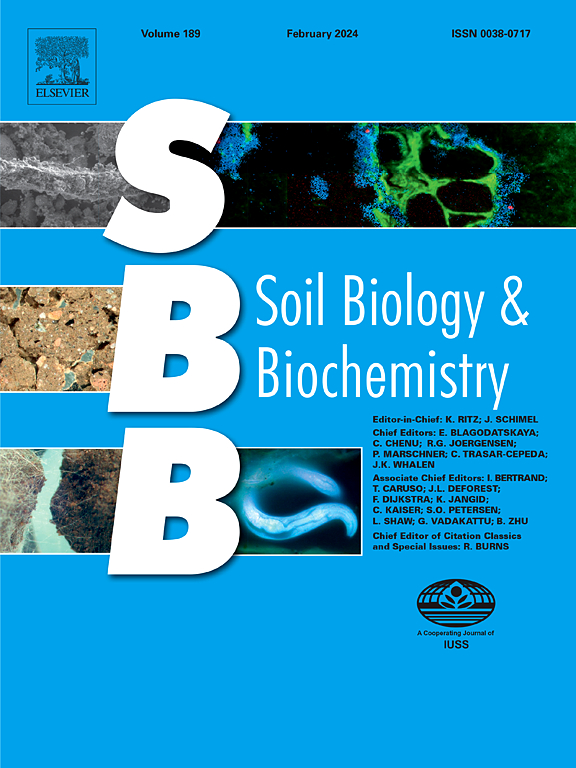让功能发挥作用:蚯蚓性状与物理化学浇注特性之间的关系
IF 10.3
1区 农林科学
Q1 SOIL SCIENCE
引用次数: 0
摘要
虽然蚯蚓在土壤生物地球化学过程中起着至关重要的作用,但它们的特征在形成其铸件的物理化学性质方面的重要性仍然知之甚少。本研究旨在(1)评价蚯蚓种类和土壤类型对铸件性能的影响;(2)探讨蚯蚓形态、解剖、生理和行为特征与其铸件理化性能的关系。以9种温带蚯蚓为研究对象,在两种不同土壤类型(Luvisol和Cambisol)的控制条件下,测定了每种蚯蚓的21个性状。分析了蚯蚓粪的理化性质、总有机碳和速效有机氮,并与相同条件下无蚯蚓的对照土进行了比较。结果表明,蚯蚓活动对土壤pH值有不同的调节作用,Cambisol的pH值升高,Luvisol的pH值降低。物种对铸件性能的影响呈现出一个理化梯度:castaneus和陆生l产生的铸件的硝酸盐、溶解有机碳、总有机碳和水分含量最高,而内源l产生的铸件的硝酸盐、溶解有机碳和水分含量最低。此外,蚯蚓种类对铸体特性的总体影响强于土壤类型(59%比24%),这表明物种特异性性状在铸体特性的塑造中起主导作用。我们确定了与蚯蚓的形态、解剖、生理和行为相关的9个关键特征,这些特征直接或间接地影响了蚯蚓的性状。直接影响性状包括口腔面积、砂囊大小和位置、斑疹鳎复杂程度、肠道粘液和铸型产量。色素沉着、凋落物摄取量和凋落物投粪比等间接效应性状反映了蚯蚓物种的生态行为。这种基于性状的方法为进一步研究蚯蚓在土壤生物地球化学循环中的作用提供了一条有希望的途径,并为进一步了解蚯蚓对土壤有机质动力学的影响提供了一个框架。本文章由计算机程序翻译,如有差异,请以英文原文为准。
Let's get functional: Relationship between earthworm traits and physicochemical cast properties
Although earthworms play a crucial role in soil biogeochemical processes, the importance of their traits in shaping the physicochemical properties of their casts remains poorly understood. This study aimed (1) to evaluate the influence of earthworm species and soil types on cast properties and (2) investigate the relationship between earthworm morphological, anatomical, physiological and behavioral traits and the physicochemical properties of their casts. Nine temperate earthworm species were introduced under controlled conditions in two contrasting soil types (Luvisol and Cambisol), and 21 traits were determined for each species. Casts were analyzed for their physicochemical properties, total and available organic carbon and nitrogen, and compared to control soil incubated under similar conditions without earthworms. Results showed that earthworm activity changed soil pH depending on soil type, with pH increasing in Cambisol, and decreasing in Luvisol. Species-specific effects on cast properties revealed a physicochemical gradient: the epigeic L. castaneus and epi-anecic L. terrestris produced casts with the highest nitrate, dissolved organic carbon, total organic carbon, and moisture levels, whereas cast from endogeic species showed the lowest values. Moreover, earthworm species exerted a stronger overall influence on cast properties than soil type (59 % vs. 24 %), underscoring the dominant role of species-specific traits in shaping cast characteristics. We identified nine key traits related to the earthworms' morphology, anatomy, physiology and behavior, that influenced cast properties directly or indirectly. Direct effect traits included mouth area, gizzard size and location, typhlosole complexity, intestinal mucus and cast production. Indirect effect traits, such as pigmentation, litter ingestion and litter-to-cast ratio, reflected the ecological behavior of earthworm species. This trait-based approach provides a promising avenue for future studies on the role of earthworms in soil biogeochemical cycling and a framework for improving our understanding of their impacts on soil organic matter dynamics.
求助全文
通过发布文献求助,成功后即可免费获取论文全文。
去求助
来源期刊

Soil Biology & Biochemistry
农林科学-土壤科学
CiteScore
16.90
自引率
9.30%
发文量
312
审稿时长
49 days
期刊介绍:
Soil Biology & Biochemistry publishes original research articles of international significance focusing on biological processes in soil and their applications to soil and environmental quality. Major topics include the ecology and biochemical processes of soil organisms, their effects on the environment, and interactions with plants. The journal also welcomes state-of-the-art reviews and discussions on contemporary research in soil biology and biochemistry.
 求助内容:
求助内容: 应助结果提醒方式:
应助结果提醒方式:


